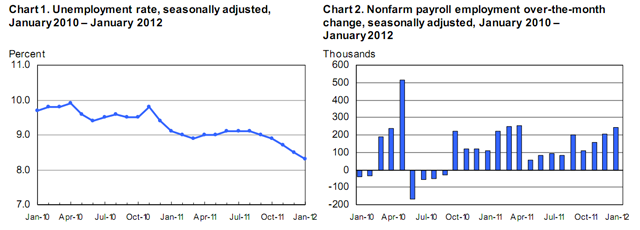In January, total employment in the United States grew in
excess of 200,000 jobs for the second consecutive month. The Labor
Department reports 243,000 positions were added in the month and
revisions show 203,000 were added in December. The U.S.
unemployment rate fell from 8.5 to 8.3 percent despite an influx of
more than 500,000 workers into the civilian labor
market.
Furthermore, revisions to previous numbers, based on more
complete data, show the employment situation may not have been as
bad as first reported. Unemployment peaked at 10 percent for a
single month in October 2009 before starting to fall. Past reports
had unemployment remaining at or above 10 percent for three months.
Revisions to 2011’s establishment data also show nearly 266,000
more jobs were created during the year than previously reported,
accounting for nearly a 20 percent improvement.

Growth did not appear overly clustered in any specific
sector in January, but rather it was spread throughout many
sectors. Manufacturing added 50,000 positions, mostly in durable
goods, likely an extension of holiday spending which seemed to
disproportionately lean towards such items. Food services and
drinking places added 33,000 positions, healthcare added 31,000 and
construction added 21,000. In the temporary help or contract
staffing space, employment grew by 20,100 after having been
relatively flat in recent months.
The unemployment rate among those who hold a four-year
degree rose from 4.1 to 4.2 percent in January, but that was mostly
driven by an increase in those who hold such a degree looking for
work. Actual employment by those with a four-year degree rose by
291,000 in January. The management, professional and related
occupations unemployment rate fell year over year from 4.7 percent
to 4.3 percent. The unemployment rate for those in sales or related
occupations also fell, from 9.1 to 8.2 percent from a year
ago.
The recovery from the Great Recession has been
characterized by fits and starts. Indeed, when comparing the speed
of the labor market’s recovery to past recessions, our current path
is both longer and slower than any recovery over the last half
century. The improvements seen over the last few months though,
point to the beginning of a virtuous cycle, with an unemployment
rate falling more precipitously than would have been projected just
a few months ago.
